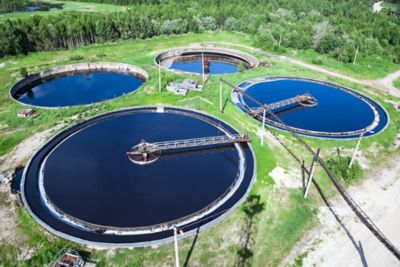All about compressed air blowers
Blowers are compressed air equipment specially developed for applications requiring low pressure between 0.3 and 1,5 bar(g)/ 4 and 22 psi. By correctly choosing these equipment according to size and application, huge savings in energy consumption can be generated. Learn below how this type of equipment works, the types that exist and their main applications.
How do air blowers work?
Initially, air is drawn in by the suction side of the device, rotors and impellers spin, the air is then pressurized and released. Depending on how they move the air, blowers can be classified as positive displacement or centrifugal:
- Positive displacement blowers
These types of blowers, which house two rotors, trap a certain volume of air. As the rotors spin, air is drawn toward the inlet side of the blower and passes into the tight areas between the rotors and the blower housing.
This air moves around the rotors and blower housing to the outlet side. When the rotors open toward the outlet side, the discharge line equalizes the air pressure. - Centrifugal air blowers
Air enters the center of a rotating impeller and is split between the impeller blades. As the impeller spins, it accelerates the air outward using centrifugal force. In the surrounding blower housing, this high-velocity air diffuses and slows to create pressure. Read more on centrifugal technology
Compressed air blower types
According to the type of technology, we can mention 5 types of compressed air blowers.
- Rotary lobe blowers (also known as roots blowers)
Rotary lobe blowers consist of two rotors that rotate in opposite directions. The blower draws in air and the lobes rotate around the air before expelling it. They produce a high volume of air, but at low pressure.
- Rotary Screw Blowers
The rotary screw blower combines male and female rotors that rotate and decrease the volume of air available between them, causing the air to be compressed. At the beginning of the compression cycle, the inlet air fills the compression chamber space and is trapped. This is continuously compressed as the male and female rotors rotate with each revolution until the air is pushed through the discharged outlet.
Compared to traditional lobe blowers, the internal compression of rotary screw blowers reduces energy consumption by 30%. By eliminating the pulsations caused by lobe technology, screw blowers' noise levels are three to five times quieter than conventional three-lobe blowers.
- Multistage centrifugal blower
When an air stream passes through the rotating impellers of a centrifugal blower, the speed and volume increase. The blower changes the direction of the airflow, the air enters the fan wheel, rotates 90 degrees, and accelerates before exiting the blower. On the other hand, the multistage centrifugal blower is used to create pressure, circulate air, and generate suction.
This blower can handle high pressures and high flow rates, it is ideal for creating high pressure from small volumes of air. They are suitable for all operations where variable flow at constant pressure is required, the performance characteristics of these blowers generate variable flow and power at a constant speed. To generate more flow, impeller diameters need to be increased. More impellers are required to create more pressure.
- High speed turbo blowers
High-speed turbo blowers are advanced air-moving devices designed for efficiency and energy conservation in various industrial applications. They are particularly prevalent in wastewater treatment plants, food and beverage, and the petrochemical industry. These blowers operate at high speeds to maximize airflow while minimizing energy consumption, making them a cost-effective solution for continuous operation. With models ranging from small to large horsepower, they cater to a wide range of volume requirements. High-speed turbo blowers are a testament to modern engineering, offering a blend of performance, reliability, and innovation. They represent a significant step forward in blower technology, providing industries with a powerful tool to meet their air movement needs effectively.
- Geared turbo blowers
Geared turbo blowers, also known as integrally geared centrifugal blowers, are a pivotal technology in modern wastewater treatment plants and various industrial applications. They are designed to offer high efficiency and reduced energy consumption, which can lead to significant cost savings.
These blowers work by utilizing gears to increase the speed of the air being moved, allowing for a compact design that can handle large volumes of air at high pressures. Their adaptability to different flow ranges and conditions makes them a versatile choice for industries looking to optimize their aeration processes and reduce operational costs. With advancements in technology, geared turbo blowers continue to evolve, providing a reliable and energy-efficient solution for aeration needs.
Air blowers applications and industries
Below we present some of the sectors where we recommend, taking into account the type of applications they handle, the use of industrial air blowers .
- Food and Beverage
Includes fermentation, meat processing, dairy manufacturing, and the poultry industry. - Wastewater Treatment
Wastewater is introduced into tanks that are home to millions of bacteria that feed on organic waste. These bacteria break down the water into harmless byproducts containing carbon dioxide, nitrogen, and water. Because these bacteria require oxygen to survive, large amounts of compressed air are introduced into aeration tanks to speed up the process. - Pneumatic Conveying
Used to move any dry bulk material including powders, granular forms, chips, and pellets. For example: cement, lime, detergent, etc. - Mining
Provides ventilation in coal mines by removing methane gas from underground basins in these mines in a process called methane gas stripping. Used to improve the concentration by flotation & leaching. - Cement Industry
Blowers oxygenate cement structures, keep the raw material moving, cool the mixture after it leaves the kiln, and supply oxygen to the fire. Blowers keep the raw material moving, supply air for the combustion process & can be used to clean SCR catalysts.

